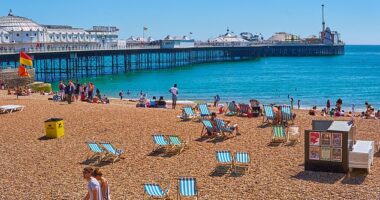Scott Anderson was living in Brooklyn with his wife and two children when the coronavirus hit, closing all of the city’s schools and sending his children into the netherworld of online education.
The family moved to its weekend house in Dutchess County, N.Y. The children, one a freshman and the other a sophomore at an independent school in Brooklyn where they had been since prekindergarten, were unhappy with their online classes. Their parents, meanwhile, were paying an annual tuition of over $50,000 for each.
“This is the time for them to strike out and explore things,” Mr. Anderson said. “Their school was completely unprepared for this style of teaching and for engaging a class.”
As the summer wore on, the Andersons decided to enroll their children in a boarding school, the Frederick Gunn School in Washington, Conn., 45 minutes from their weekend house.
In making a change they had never contemplated before the pandemic, they joined a surge of affluent parents who have upended their plans in order to get their children into independent schools holding in-person classes for the fall. It didn’t come cheap — the Frederick Gunn School costs $66,523 for boarding students — but in-person learning was not going to be possible at many public schools and even at well-regarded day schools in big cities hit hard in the pandemic.
“Applications are up, and enrollment is up,” said Carole J. Everett, executive director of the New Jersey Association of Independent Schools. “This is largely due to people fleeing the city and public school parents disappointed that their schools haven’t opened in person. It really picked up over the summer and has continued into the fall.”
The National Association of Independent Schools said in August that 58 percent of its schools had reported an increase in interest from the previous summer.
That uptick has helped the private day and boarding schools shore up their balance sheets, especially when some of their most lucrative students — full-pay international students, many from Asia, who are charged as much as $75,000 a year — didn’t return this year.
“We have families who were six months ago enrolled in day schools, primarily in New York, and boarding school wasn’t on their radar,” said Peter Becker, head of the Frederick Gunn School.
The surge in summer and fall applications for schools offering in-person education has been as uneven geographically and economically as the coronavirus itself.

In the Northeast, it’s boom time. Thirty-six percent schools in New England reported a rise in enrollment from last year — the largest increase in the nation — as schools opened in September, according to the National Association of Independent Schools. But the New York metropolitan area reported a 56 percent drop in private school enrollment.
Sacred Heart, in Greenwich, Conn., just 35 miles from New York City, accepted 22 students after the normal admissions cycle closed and would have accepted more if certain grades were not full, said Meg Frazier, the head of school. She said interest was driven by city families but also nearby families whose children were struggling with online public education.
At Doane Academy, a day school for kindergarten through 12th grade in Burlington, N.J., 20 new students are entering, which is substantial given that the school now has just 253 students, said George Sanderson, head of school.
The Southeast is a different story. Many schools in Florida had acceptance deadlines before stay-at-home orders began in mid-March, largely filling their classrooms before the pandemic worsened. But other schools in the region struggled to hold on to students, with 59 percent reporting lower enrollment this year.
Jay Lasley, director of admissions at Berkeley Prep in Tampa, Fla., said he had fielded a surge in calls from parents in Chicago and New York who wanted to move. He was able to accommodate a few families with students who were not in grades like fifth and ninth, when children typically shift to a new school and apply early, but not as many older children.
The interest remains, Mr. Lasley said. Applications in the first month of the 2020-21 school year are outpacing what they normally are for an entire admissions season.
In California, most public schools remain remote or a combination of in-person and distance learning, and so are most private schools. Some 80 percent of them with middle and upper schools are not teaching fully or at all in person, said Deborah Dowling, executive director of the California Association of Independent Schools.
Some boarding schools in the state, though, have managed to keep the virus at bay, and they have siphoned students from day and public schools. The Army and Navy Academy, a military boarding school for boys in Carlsbad, Calif., reopened with strict rules around staying on campus throughout the semester.
Michelle and Michael Foster enrolled their son this fall at the Army and Navy Academy after seeing him struggle and become distracted in the online learning at his private day school in Los Angeles.
“We’d looked at boarding school a couple of years ago, but that was prepandemic,” Ms. Foster said. “This is his junior year, and we wanted to give him the best education he could get.”
But even some private schools in Los Angeles that are online until the county tells them otherwise have attracted new parents. George and Heather Ellis, who have three sons and live in the Sherman Oaks section, said they had watched their oldest boy, then in first grade, completely lose interest with remote learning in public school. They, like many others, rushed to apply to an independent school.
They were put on the waiting listed at the Buckley School and began the school year at their public school. They said their two older sons, now in second grade and kindergarten, had little to do during the day as a single teacher struggled to manage a class on Zoom.
When the Ellises were offered a place for their two sons at the Buckley School, they accepted at once. “Covid definitely propelled us to make the change,” Mr. Ellis said. “I don’t want to devalue what a hard job it is for one teacher to manage 26 kids online. At Buckley, it’s not just homeroom teachers. It’s specials teachers. It’s P.E. It’s a full day, from 8:30 to 3 p.m. every day.”
Still, these parents are paying tens of thousands of dollars for private Zoom school, and not everyone is happy with that arrangement. In New York, parents at one of the city’s most elite private schools, the Dalton School, which remains remote even when competitors have in-person learning, have begun to complain.
Its reputation for excellent teaching and college placement keeps parents from leaving, said Emily Glickman, president of Abacus Guide Educational Consulting, which works with families to get their children into private schools in New York. Schools with less competitive reputations have struggled more.
“It’s interesting because parents are all looking left and right to see what their friends’ kids are doing,” Ms. Glickman said. “No one is sure what is better.”
Still, after hearing friends speak highly of their children’s private school, some parents are rolling the dice and paying for private school even knowing that the schools may have to go virtual at some point. They said the financial sacrifice was worth it, given the alternative of their children staring at a screen and attending school intermittently now and having little work to do if the public schools go virtual in the winter.
Jennifer and Spiros Liras, who live in Brookline, Mass., and work in Boston, moved their family to their weekend home in Stonington, Conn, so their 14-year-old twins could enroll at the Williams School, a day school in New London, Conn.
“We were nervous in July when we hadn’t heard about the school’s plans for mitigating risks,” Ms. Liras said. “They’re very dated schools that are very crowded.”
Their children are thriving with in-person learning, but she said she worried about what would happen when she and her husband could no longer work remotely and needed to return to their offices.
Kim Leipham Freedman, head of New Garden Friends School in Greensboro, N.C., an area rich with colleges and universities, said she had several families who went through the admissions process over the summer but had to pull out at the end when they decided they couldn’t afford the tuition, which is $22,000 a year for the upper grades and $17,000 for the lower grades. She said the school could have added more families if price weren’t an object.
“Many of them think they’re going to get a ton of financial aid,” Ms. Freedman said. “We do what we can, but we lost many families at the end.”
One thing many independent schools are doing is giving financial aid to existing students whose families have been affected by the pandemic. New families are generally out of luck: Most financial aid budgets are spent every year by summer.
If independent schools are a barometer, the pandemic is continuing to affect families’ education plans. Many private schools, like Berkeley Prep in Tampa, are reporting application requests for next year that are many times higher than in a normal year.
Source: | This article originally belongs to Nytimes.com








